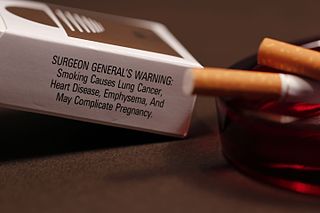
A tobacco pipe, often called simply a pipe, is a device specifically made to smoke tobacco. It comprises a chamber for the tobacco from which a thin hollow stem (shank) emerges, ending in a mouthpiece. Pipes can range from very simple machine-made briar models to highly prized hand-made artisanal implements made by renowned pipemakers, which are often very expensive collector's items.

Tobacco is the common name of several plants in the genus Nicotiana of the family Solanaceae, and the general term for any product prepared from the cured leaves of these plants. More than 70 species of tobacco are known, but the chief commercial crop is N. tabacum. The more potent variant N. rustica is also used in some countries.

A bong is a filtration device generally used for smoking cannabis, tobacco, or other herbal substances. In the bong shown in the photo, the smoke flows from the lower port on the left to the upper port on the right.

Tobacco smoking is the practice of burning tobacco and ingesting the resulting smoke. The smoke may be inhaled, as is done with cigarettes, or simply released from the mouth, as is generally done with pipes and cigars. The practice is believed to have begun as early as 5000–3000 BC in Mesoamerica and South America. Tobacco was introduced to Eurasia in the late 17th century by European colonists, where it followed common trade routes. The practice encountered criticism from its first import into the Western world onwards but embedded itself in certain strata of a number of societies before becoming widespread upon the introduction of automated cigarette-rolling apparatus.

A hookah, shisha, or waterpipe is a single- or multi-stemmed instrument for heating or vaporizing and then smoking either tobacco, flavored tobacco, or sometimes cannabis, hashish and opium. The smoke is passed through a water basin—often glass-based—before inhalation.

World No Tobacco Day (WNTD) is observed around the world every year on 31 May. The annual observance informs the public on the dangers of using tobacco, the business practices of tobacco companies, what the World Health Organization (WHO) is doing to fight against the use of tobacco, and what people around the world can do to claim their right to health and healthy living and to protect future generations.

Pipe smoking is the practice of tasting the smoke produced by burning a substance, most commonly tobacco or cannabis, in a pipe. It is the oldest traditional form of smoking.

A kiseru (煙管) is a Japanese smoking pipe, traditionally used for smoking kizami, a finely shredded tobacco product resembling hair.

Tobacco products, especially when smoked or used orally, have serious negative effects on human health. Smoking and smokeless tobacco use are the single greatest causes of preventable death globally. Half of tobacco users die from complications related to such use. Current smokers are estimated to die an average of 10 years earlier than non-smokers. The World Health Organization estimates that, in total, about 8 million people die from tobacco-related causes, including 1.3 million non-smokers due to secondhand smoke. It is further estimated to have caused 100 million deaths in the 20th century.

A tobacconist, also called a tobacco shop, a tobacconist's shop or a smoke shop, is a retail business that sells tobacco products in various forms and the related accoutrements, such as pipes, lighters, matches, pipe cleaners, and pipe tampers. More specialized retailers might sell ashtrays, humidification devices, hygrometers, humidors, cigar cutters, and more. Books and magazines, especially ones related to tobacco are commonly offered. Items irrelevant to tobacco such as puzzles, games, figurines, hip flasks, walking sticks, and confectionery are sometimes sold.

Sales of cigarettes and smoking in the UK are being gradually restricted during the first few decades of the 21st century. The Tobacco and Vapes Bill, to ban sales of cigarettes to people born after 2008, is being debated in parliament in 2025.
No Smoking Day is an annual health awareness day in the United Kingdom which is intended to help smokers who want to quit smoking. The first No Smoking Day was on Ash Wednesday in 1984, and it now takes place on the second Wednesday in March.

A smoking pipe is used to taste the smoke of a burning substance; most common is a tobacco pipe. Pipes are commonly made from briar, heather, corncob, meerschaum, clay, cherry, glass, porcelain, ebonite and acrylic.

Nicotine withdrawal is a group of symptoms that occur in the first few weeks after stopping or decreasing use of nicotine. Symptoms include intense cravings for nicotine, anger or irritability, anxiety, depression, impatience, trouble sleeping, restlessness, hunger, weight gain, and difficulty concentrating. Withdrawal symptoms make it harder to quit nicotine products, and most methods for quitting smoking involve reducing nicotine withdrawal. Quit smoking programs can make it easier to quit. Nicotine withdrawal is recognized in both the American Psychiatric Association Diagnostic and Statistical Manual (DSM) and the WHO International Classification of Diseases (ICD).

A one-hitter is typically a slender pipe with a screened narrow bowl designed for a single inhalation, or "hit", of smoke or vapor from a small serving of heated cannabis flower, tobacco leaf or other dry, sifted herbal preparation. It is distinguished from western-style large-bowl pipes designed for strong tobaccos that are burned hot and tasted but not inhaled. Instead, by properly distancing a lighter flame below the opening, inhalant users operate at vaporization temperatures, minimizing combustion waste and toxicity.

Smoking is a practice in which a substance is combusted and the resulting smoke is typically inhaled to be tasted and absorbed into the bloodstream of a person. Most commonly, the substance used is the dried leaves of the tobacco plant, which have been rolled with a small rectangle of paper into an elongated cylinder called a cigarette. Other forms of smoking include the use of a smoking pipe or a bong.

Tobacco control is a field of international public health science, policy and practice dedicated to addressing tobacco use and thereby reducing the morbidity and mortality it causes. Since most cigarettes and cigars and hookahs contain/use tobacco, tobacco control also concerns these. E-cigarettes do not contain tobacco itself, but (often) do contain nicotine. Tobacco control is a priority area for the World Health Organization (WHO), through the Framework Convention on Tobacco Control. References to a tobacco control movement may have either positive or negative connotations, depending upon the commentator.

Inflight smoking is the act of smoking tobacco on an aircraft while in flight. While once prevalent, it is now prohibited by almost all airlines and by many governments around the world. The bans on inflight smoking have been imposed in a piecemeal manner around the world beginning in the 1980s. The use of electronic cigarettes and smokeless tobacco is also prohibited.

There are approximately 61.4 million smokers in Indonesia, among a population of 273 million people. Around 63% of men and 5% of women report smoking, equating to 34% of the population. The majority, 88% of Indonesian smokers, use clove-flavoured kreteks. Kretek manufacturers directly employ over 180,000 people in Indonesia and an additional 10 million indirectly. Indonesia is the fifth largest tobacco market in the world, and in 2008 over 165 billion cigarettes were sold in the country.

















